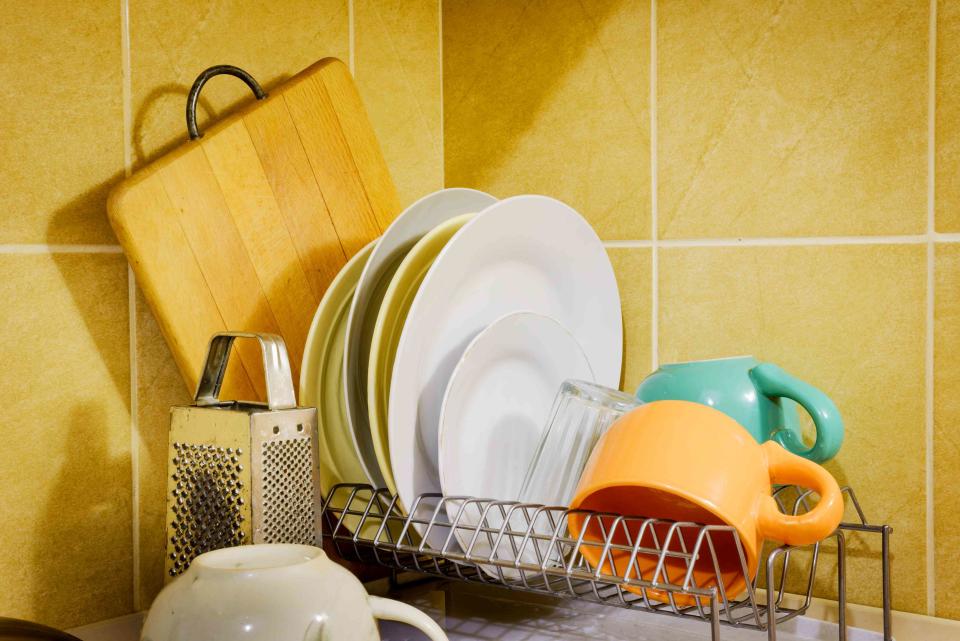How to Hand Wash Dishes the Right (and Most Sanitary) Way
Cleaning experts give us the lowdown on the best handwashing method.

Alain de Maximy/Getty Images
You may not realize it, but there’s a right way to hand wash dishes. There are specific steps you should take to make sure that the dishes are indeed clean and ready for their next use. It's also important to hand wash with care so that your dishware doesn't end up with chips and scratches. To find out the best tips and techniques, we reached out to cleaning experts to get the lowdown on how to properly hand wash your dishes to leave them sanitized and sparkling.
Related: Is It Better to Use the Dishwasher or Hand-Wash Your Dishes?
Scrape off existing food
Before you start hand washing dishes, Katie Barton, head of cleaning at Homedit, recommends first scraping excess food off dirty dishes. “Failure to do this will lead to a sink full of food and grime, which will cause your dishes to come out dirty,” she cautions. She also noted how excess food matter in the sink can also negatively affect your plumbing—especially if your plates are covered in greasy or starchy substances known for clogging pipes. Once your dishes are scraped, you are ready to begin your hand washing routine.
Related: How to Unclog a Sink Drain—6 Different Ways
Fill the sink
Use a drain stopper to plug the sink or a large dish soaking tub. Fill the sink or tub with hot water and then add a few drops of your favorite dish soap.
Start with pots and pans
Once your sink is full of hot soapy water, Barton recommends soaking all pots and pans with stuck-on food. “After about 20-30 minutes, the food will loosen, and you can scrape it off with a rubber spatula or wipe it off with a paper towel,” she said. After your pots and pans are cleaned, drain the dirty water.
Refill your sink
Just as before, add hot water and more of your preferred dish soap. Next, Barton suggests adding your least dirty dishes, which are usually cups and silverware. “Wash the dishes with a sponge, rinse clean with fresh water, and dry with a towel. Progressively move on to the dirtier dishes,” she said. If at any point your dishwater looks discolored or greasy, gets cold, or loses all suds, drain it and refill it with fresh, hot soapy water.
Use gentle applications
Angela Rubin, a cleaning expert from Hellamaid, a cleaning company in Calgary, Alberta, Canada, said to carefully select what you use to scrub dishes. “Use a sponge or dishcloth to gently scrub each dish, paying extra attention to areas with stubborn residue,” Rubin said. “Avoid using steel wool or abrasive pads on delicate surfaces to prevent scratches and damage.”
Rinse again
After washing, Rubin advises to rinse dishes under hot running water to remove any remaining soap residue. “Make sure to rinse in clean, flowing water rather than letting dishes soak in standing water, which can harbor bacteria,” she said.
Dry your dishes properly
Gently wipe-dry your dishes, pots and pans with a clean absorbent dish towel or use a clean dish rack and allow them to air dry. According to Rubin, ensure that dish towels are washed regularly to prevent the spread of bacteria and also sanitize your drying rack.
Related: The Best Ways to Dry Dishes—Including the Most Sanitary Method
Consider added hygiene steps
To further enhance sanitation, she said to consider using a bleach solution or a sanitizing spray on countertops, sinks, and dish racks. Or, you can quickly create one. “Dilute one tablespoon of bleach per gallon of water and apply it to surfaces, allowing it to air dry for maximum effectiveness,” Rubin said.
For more Real Simple news, make sure to sign up for our newsletter!
Read the original article on Real Simple.

 Yahoo Finance
Yahoo Finance 